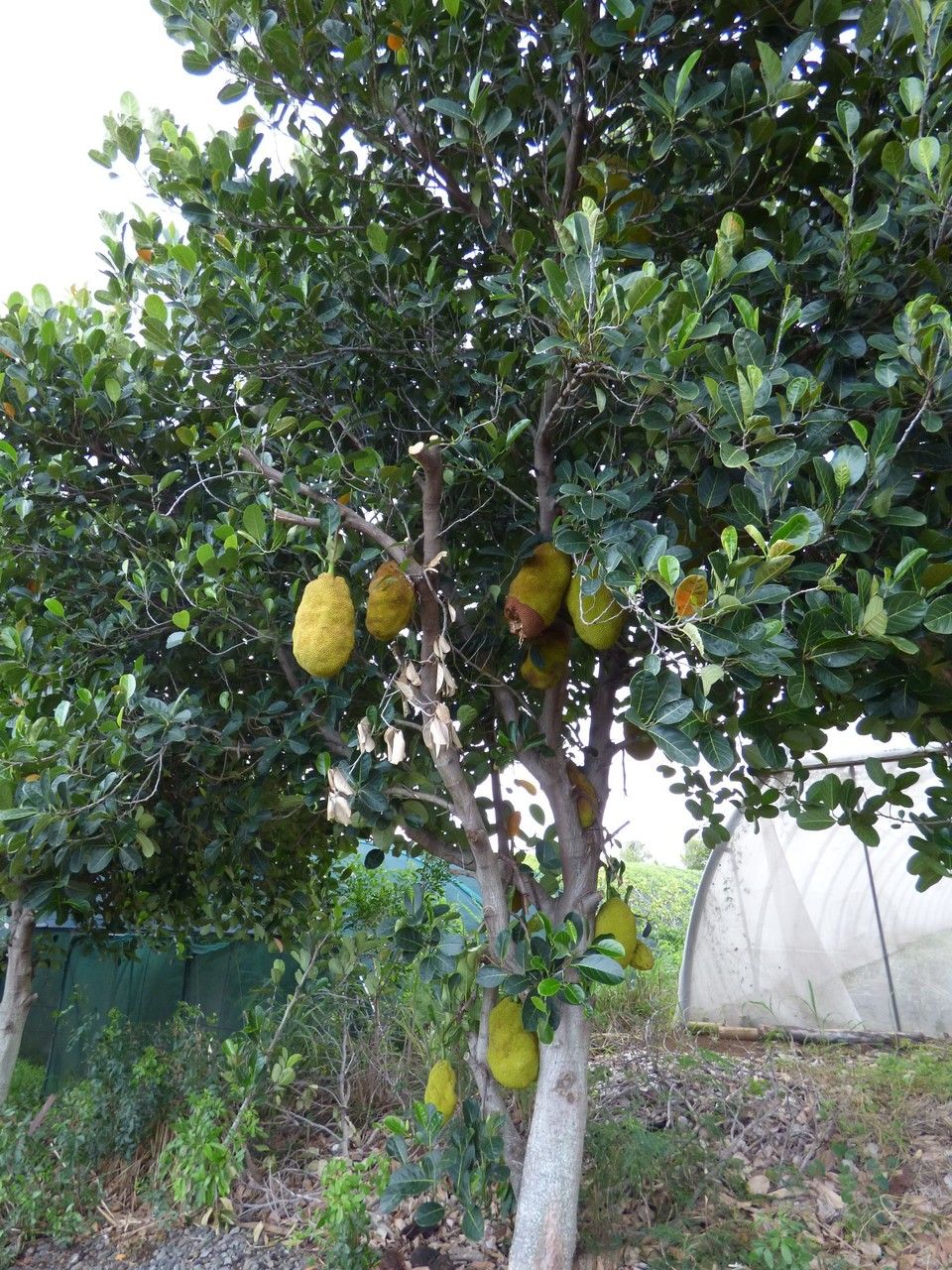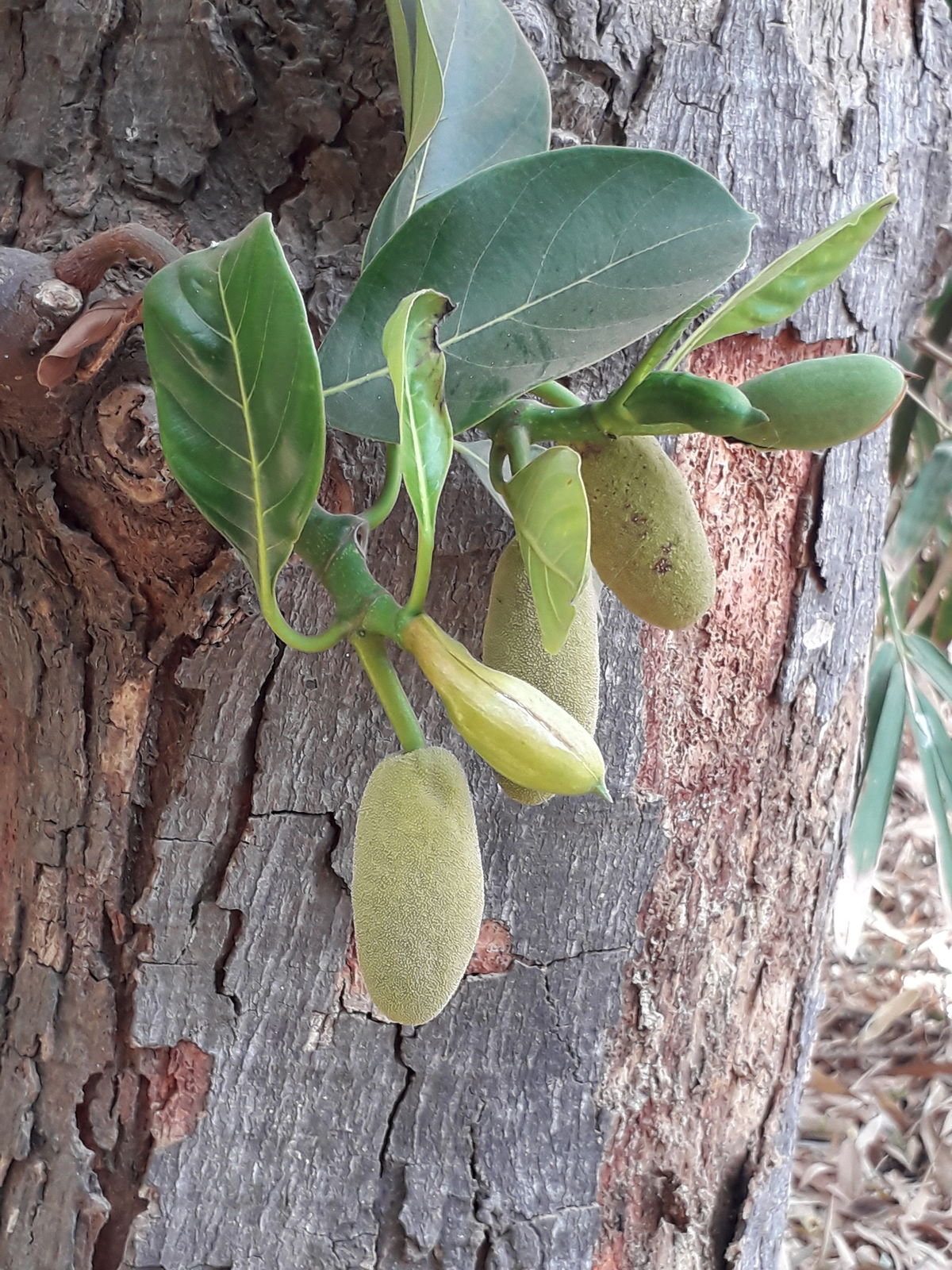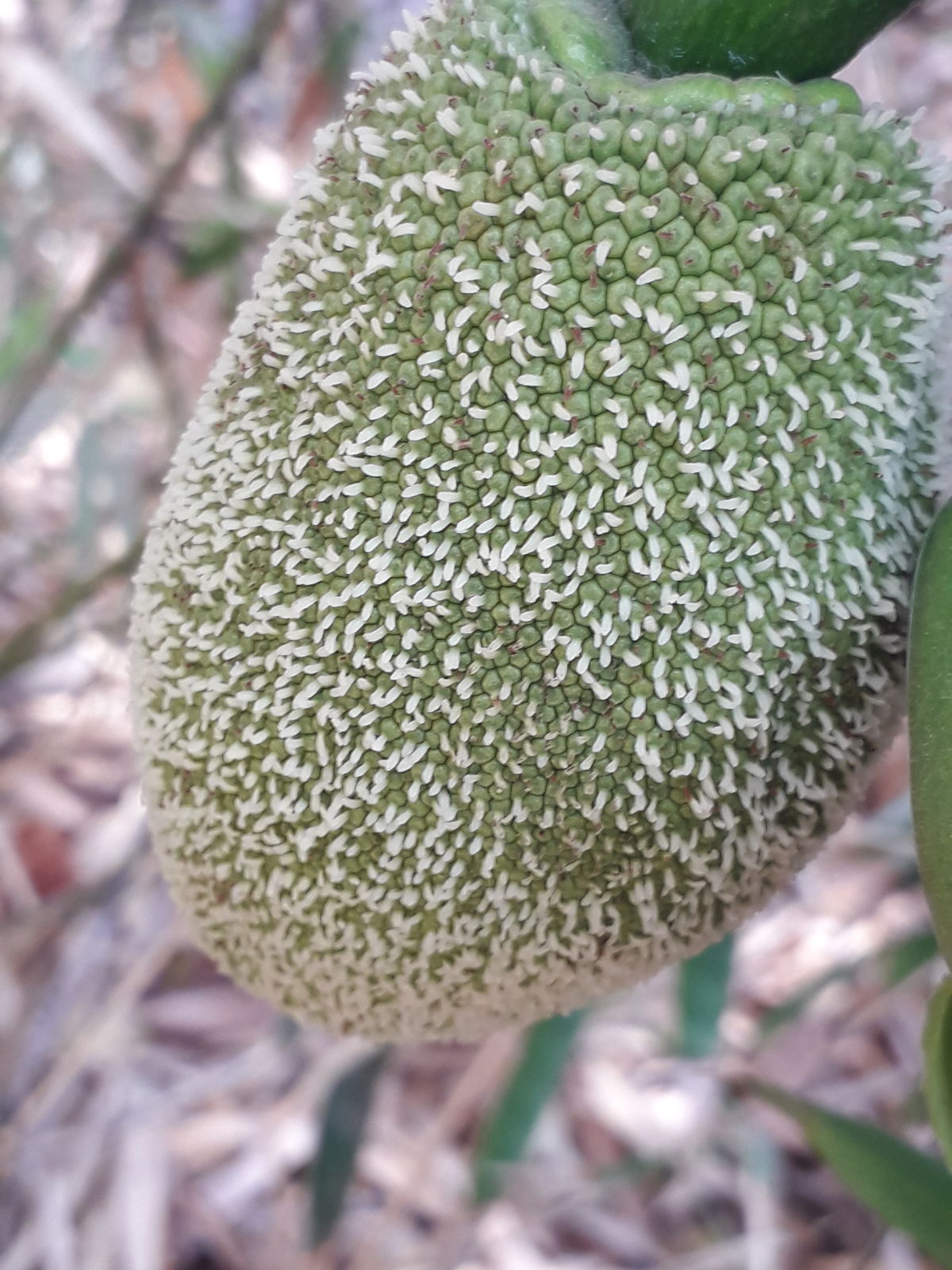Jackfruit
artocarpus heterophyllus
Also known as: ["Jack tree","Kathal","Nangka"]
Overview
A large evergreen tree native to parts of South and Southeast Asia, known for its massive, edible fruit.
Benefits & Perks
["edible fruits","fast growing","wildlife attractant (bees, butterflies, birds)"]
Botanical Classification
| Phylum: | Magnoliophyta |
| Class: | Magnoliopsida |
| Order: | Rosales |
| Family: | Moraceae |
| Genus: | Artocarpus |
| Botanical Name: | Artocarpus heterophyllus |
Plant Characteristics
Basic Information
- Category: Fruits
- Suitable Location: outdoor garden in tropical or subtropical regions
- Suitable For:
- Is Weed: No
- Allergenicity: low
Environmental Needs
- Climate: {"temperatureRange":"15–35°C"}
- Hardiness: {"zones":"10–12"}
- Misting: rarely required, only if ambient humidity is very low
- Drainage: Fast-draining to prevent waterlogging.
- Soil Type: Rich, well-draining potting mix with organic matter and some sand or perlite for aeration.
Maintenance Level
- Maintenance Level: moderate
- Toughness Level: moderate
- Pruning Frequency: Annually, after the main growing season or before flowering begins.
- Pruning Intensity: Moderate; remove up to one-third of old growth to stimulate new growth and fruiting.
Care Details
Ideal Sunlight Coverage:
Full sun to partial shade; 6–8 hours of direct sunlight daily, with some protection from intense midday sun in hot climates.
Sunlight Tolerance Tips:
Acclimate the plant gradually to direct sunlight if moving from indoors; protect from scorching by providing shade during peak summer hours; adjust placement based on indoor/outdoor conditions.
Care Requirements
Care Difficulty
moderatemoderate
Sunlight
full sun to partial shade
Rotate the plant regularly for even growth; use sheer curtains to filter intense light indoors; provide dappled shade in hot climates.
Watering
every 7–10 days during active growth, reducing in winter
Water thoroughly until it drains from the bottom; allow soil to dry slightly between waterings; avoid overwatering.
Soil
rich, well-draining loamy soil with organic matter
pH: Slightly acidic to neutral (pH 5.5–7.0).
Use a mix of peat, pine bark, and perlite; avoid heavy clay soils; ensure good drainage to prevent root rot.
Temperature
Prefers warm temperatures, ideally 25–35°C (77–95°F); tolerates brief periods of cooler temperatures but thrives in tropical conditions.
Avoid sudden temperature changes; protect from frost; maintain consistent warmth for optimal growth.
Fertilizing
every 4–6 weeks during growing season with balanced fertilizer
Dilute liquid fertilizer to half strength to avoid burning roots; apply fertilizer to moist soil to prevent root damage; avoid fertilizing newly transplanted or stressed plants.
Propagation
Methods
Stem cuttings or air layering; stem cuttings are more common for home growers.
Step-by-Step Propagation Guide
- Select a healthy stem.
- Cut just below a node.
- Apply rooting hormone.
- Plant in moist propagation medium.
- Maintain humidity and warmth.
Best Time: Spring or early summer when the plant is actively growing.
Environment
High humidity (70–90%), warm temperatures (25–30°C), and indirect light.
Medium
Well-draining potting mix with perlite or sand; can also be rooted in water initially.
Hormone
Rooting hormone is recommended to improve success rates.
Timeline
Roots may develop in 4–8 weeks; establishment can take several months.
Tools Needed
Pruning shears, rooting hormone, propagation tray, humidity dome, well-draining medium.
Quick Tips
Keep soil consistently moist but not waterlogged; maintain high humidity with a plastic bag or dome; provide indirect light for best results.
Pruning & Repotting
Pruning Guide
Method
Selective pruning of branches to improve air circulation and light penetration; avoid heavy pruning during flowering or fruiting.
Pruning Plan
Prune to maintain shape, remove dead or diseased branches, and encourage fruit production.
Tools
Pruning shears, loppers, gloves, disinfectant for tools.
Checklist
Disinfect tools; prune dead or crossing branches; shape the plant; avoid over-pruning; clean up debris after pruning.
Repotting Guide
Best Season
Spring, before the active growing season begins.
Pot Size
Increase pot size by 2–5 cm (1–2 inches) in diameter; ensure the new pot has drainage holes.
Method
Remove the plant carefully; trim any circling roots; place in a new pot with fresh, well-draining soil; water thoroughly after repotting.
Suggestions
Repot every 2–3 years or when roots outgrow the container; necessary to refresh soil and provide space for growth.
Checklist
Choose appropriate pot size; prepare fresh soil mix; gently remove plant; prune roots if necessary; water after repotting; place in appropriate light.
Advanced Care Tips
Watering Mastery
Watering Checklist
Check soil moisture before watering; water deeply; ensure proper drainage; adjust frequency seasonally.
How to Apply Water Properly
Water at the base of the plant, ensuring moisture reaches the root zone; water early in the morning to minimize evaporation; ensure excess water drains away to prevent waterlogging.
Watering Schedule Tips
Water deeply once the top inch of soil feels dry; reduce frequency in winter to prevent root rot.
Soil Improvement
Add perlite or coarse sand for drainage; incorporate compost for fertility; ensure soil is loose and well-aerated.
Temperature Stress Management
Signs of Temperature Issues
Chlorosis (yellowing leaves), leaf drop, stunted growth, or wilting due to extreme heat or cold.
Cold Stress
Low temperatures slow growth and can cause leaf drop or damage; prolonged cold may lead to root rot or death.
Solution: Protect from frost with a frost cloth or move indoors in cold climates; ensure good drainage to prevent cold-induced root rot.
Hot Stress
Excessive heat can cause leaf scorch, wilting, or reduced fruit production; may lead to dehydration if water needs are not met.
Solution: Provide shade during peak heat; increase watering frequency; ensure good air circulation to reduce heat stress.
Fertilizing Guide
Fertilizing Checklist
Use balanced fertilizer; apply during growing season; dilute properly; avoid overfertilization.
Fertilizing Method
Use a balanced, slow-release fertilizer every 2–3 months during the growing season (spring and summer); reduce or stop fertilizing in fall and winter.
Common Problems & Solutions
Toxicity Warning
Cats
Slightly ToxicCats may experience mild gastrointestinal upset if they ingest the latex, skin, or unripe fruit of Artocarpus heterophyllus. The proteolytic enzymes can irritate the digestive tract.
⚠️ Symptoms:
🌿 Toxic Parts:
⚡ Toxic If:
if ingested, especially latex or unripe fruit
Dogs
Slightly ToxicDogs may experience mild gastrointestinal upset if they ingest the latex, skin, or unripe fruit of Artocarpus heterophyllus. The proteolytic enzymes can irritate the digestive tract.
⚠️ Symptoms:
🌿 Toxic Parts:
⚡ Toxic If:
if ingested, especially latex or unripe fruit
Humans
Slightly ToxicThe latex and skin of Artocarpus heterophyllus contain proteolytic enzymes and irritants that can cause mild to moderate gastrointestinal distress and skin irritation upon contact. Unripe fruit may also cause discomfort due to higher levels of these compounds.
⚠️ Symptoms:
🌿 Toxic Parts:
⚡ Toxic If:
if eaten raw or improperly prepared
Frequently Asked Questions
Q: Is jackfruit safe for pets?
A: Yes, jackfruit is non-toxic to dogs and cats.
Q: How long does it take for a jackfruit tree to bear fruit?
A: It typically takes 3-4 years after planting for a jackfruit tree to start producing fruit.
Q: Can jackfruit be grown in colder climates?
A: Jackfruit trees thrive in tropical and subtropical climates and are not cold hardy.
Quick Reference
| Family: | Moraceae |
| Care: | moderate |
| Light: | full sun to partial shade |
| Water: | every 7–10 days during activ |
Get Expert Care Tips
Download the Plantious app for personalized care reminders and plant identification!
Google Play App Store








